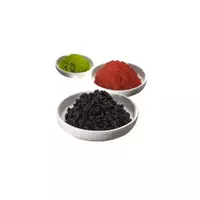Caviar masago

Often in the recipe of Asian dishes there are components, the names of which have never been found before for most of the inhabitants of our latitudes. For example, a frequent ingredient in sushi and caviar rolls masago. This product has several names - chaplain caviar or capelin (uek) masago. Under the unusual name of the chaplain's fish, not some exotic species of freshwater is hidden, but a well-known capelin. Capelin fish belongs to the smelt family.
Capelin is considered an important commercial fish that is mined in the waters of the Pacific, Atlantic oceans, as well as in the Barents and Norwegian seas. Capelin fish live near the coastline of Greenland, Canada, the USA, the Russian Federation and even the Arctic. The name Caplain Captive received thanks to the English language. The fact is that the scientific name of the capelin Mallotus villosus in English sounds like a chaplain.
Most domestic specialty stores with goods for cooking sushi, rolls and sashimi took advantage of the second exotic name of the product. Agree, capelin caviar sounds not as intriguing and Japanese as masago caviar. The main suppliers of masago caviar in the world market can be considered the Russian Federation, Canada and Iceland. It is noteworthy that capelin fish have subspecies that differ in some features in the appearance of individuals and their habitat.
So off the coast of Japan, such a species of wash as Shishamo (柳葉魚) or fish "like a willow leaf" is common. Shishamo got such a poetic name for the capelin due to its appearance (thin and elongated), which really resembles the leaves of the willow tree. Japanese capelin belongs to the genus Spirinchus, and is also classified as Spirinchus lanceolatus). The fish lives exclusively off the coast of the island of Hokkaido. From this type of capelin, the Japanese get real masago caviar, which is customary to decorate the top of Gunkan-maki or use in California rolls, as well as in other types of sushi.
The main difference between Japanese capelin and other representatives of the same fish is that Shishamo belongs to freshwater species, and most species of capelin live exclusively in salty sea or ocean water. The Japanese use not only masago caviar, but also prepare other dishes from Shishamo fish. For example, they fry the whole fish without removing the masago caviar or removing the head. Naturally, masago caviar can have several color shades from yellowish white to orange. In the food industry, masago caviar is tinted with dyes to produce different colors of the product.
There are red, black, orange, white, yellow and green masago caviar. The product has a rather specific taste, so masago caviar is often harvested with the addition of spices, chicken eggs, soybean oil or mayonnaise. The composition of masago caviar contains a large amount of vitamins of group A, C, D and B, as well as essential natural fatty acids. Masago caviar will be a wonderful and healthy ingredient in a healthy person's balanced diet.
caviar masago 140 kKal
Energy value of masago caviar (Ratio of proteins, fats, carbohydrates - ju):
Proteins: 22 g (~ 88 kCal)
Fats: 6 g (~ 54 kCal)
Carbohydrates: 1g (~ 4kCal)
Energy ratio (bj | y): 63% | 39% | 3%
 Español
Español Français
Français Português
Português Русский
Русский 简体中文
简体中文 繁體中文
繁體中文 日本語
日本語 한국어
한국어 العربية
العربية Türkçe
Türkçe Қазақ
Қазақ Deutsch
Deutsch Italiano
Italiano Українська
Українська
